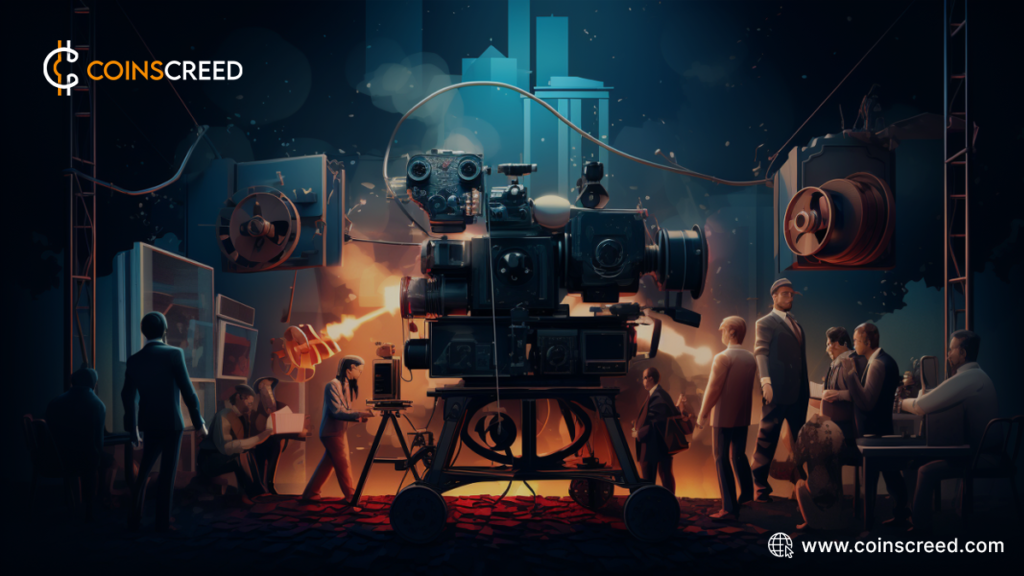The film industry has a long history of embracing technological advancements, from the introduction of sound and color to the rise of CGI and 3D technologies.

Today, the industry is on the verge of yet another transformation with the emergence of the metaverse. This digital frontier promises to redefine how films are produced, distributed, and consumed.
In this article, we’ll discuss the various ways the film industry is adapting to the metaverse era, shedding light on the future of cinema in this new virtual landscape.
Understanding the Metaverse
To comprehend how the film industry is evolving in response to the metaverse, it is crucial first to understand what the metaverse entails. The metaverse is a collective virtual space that merges physical and digital realities, offering a network of interconnected 3D worlds where users can interact, socialize, work, and play in real-time.
Unlike traditional online experiences, the metaverse provides immersive environments that continue to exist and evolve even when users are not actively engaging with them.
In essence, the metaverse is not just a new platform; it represents an entirely new medium that integrates elements of gaming, social media, and entertainment. This new medium is poised to revolutionize the film industry by offering unprecedented opportunities for creativity, collaboration, and audience engagement.
How the Film Industry is Adapting to the Metaverse Era
One of the most profound ways the metaverse influences the film industry is in the production area. Virtual production techniques, which have gained traction over the past few years, are now central to filmmaking in the metaverse era. These techniques not only enhance creative possibilities but also streamline the production process. They include:
Virtual Sets and Locations
The metaverse allows filmmakers to create entire worlds within a digital space, providing them with unlimited creative freedom. Previously, filmmakers were often constrained by the availability and cost of physical locations. However, with the metaverse, these constraints are virtually eliminated. Filmmakers can design intricate, fantastical, or historically accurate settings without the need for physical sets.
Moreover, these virtual environments can be reused, modified, and expanded, reducing both the time and cost associated with traditional film production. For example, a single virtual set can be used across multiple scenes, films, or even by different filmmakers, creating a shared creative resource.
Real-time Collaboration
The metaverse facilitates real-time collaboration between filmmakers, actors, and production teams, regardless of their physical locations. This capability is particularly valuable in an increasingly globalized industry, where talent and resources are often spread across different parts of the world.
Through the metaverse, directors can work with actors who are miles apart, and production designers can build and modify sets while receiving immediate feedback. This level of collaboration not only enhances the creative process but also leads to more efficient workflows, reducing the time it takes to bring a film from concept to completion.
Digital Avatars and Motion Capture
Motion capture technology, used in films like Avatar and The Lion King, is being taken to new heights in the metaverse. In the metaverse, actors can perform in entirely virtual environments, with their movements and expressions captured and translated onto digital avatars in real-time.
This technology allows for a new level of realism in CGI-driven films, enabling actors to interact with virtual environments and other characters in ways that were previously impossible. Additionally, these digital avatars can be integrated seamlessly into the metaverse, where they can interact with audiences and even participate in virtual events related to the film.
Distribution and Audience Engagement in the Metaverse
The metaverse is not only transforming how films are produced but also how they are distributed and consumed. In this new era, conventional models of distribution and audience engagement are being reimagined to take advantage of the unique capabilities of the metaverse. Here’s how films are being distributed in the metaverse:
Virtual Theaters and Screenings
In the metaverse, films can be premiered and screened in virtual theaters, where audiences worldwide can gather to watch and discuss the latest releases. These virtual screenings offer a social experience similar to attending a physical movie theater but with added layers of interactivity.
For instance, audiences can explore themed environments related to the film, participate in Q&A sessions with filmmakers, and even interact with characters from the movie. This creates a more engaging and immersive experience, where viewers are not just passive observers but active participants in the cinematic journey.
Decentralized Distribution
Blockchain technology, a vital metaverse component, enables decentralized distribution models that empower filmmakers to release their work directly to audiences. This approach bypasses traditional distribution channels, such as studios and streaming platforms, giving filmmakers greater creative control and the potential for more equitable revenue sharing.
Through decentralized platforms, filmmakers can distribute their films as digital assets that audiences can purchase, rent, or even trade. This model also allows for the creation of limited-edition digital copies, which can become valuable collectibles, further enhancing the connection between filmmakers and their audience.
Enhanced Audience Participation
In the metaverse, audiences are no longer confined to being mere spectators. Instead, they can become active participants in the story. Through interactive experiences, viewers can explore different narrative paths, influence the outcome of a film, or even become part of the story themselves.
This level of engagement creates a more personalized experience, where each viewer’s journey through the film can be unique. It also blurs the line between film and game as filmmakers experiment with new forms of interactive storytelling that take full advantage of the metaverse’s capabilities.
Conclusion
The film industry is entering a new era of innovation and transformation as it adapts to the metaverse. From virtual production techniques and decentralized distribution to immersive storytelling and NFTs, the metaverse is reshaping every aspect of cinema.
As filmmakers and audiences continue to explore this new world, the possibilities for creativity and connection are endless. The metaverse is not just changing how films are made and watched; it is redefining the essence of what it means to experience a film.
